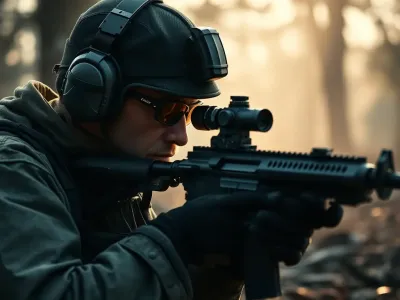
A Ukrainian sniper is believed to have shattered the world record for the longest confirmed kill shot in history, firing from more than two-and-a-half miles away during a mission in the country’s embattled east.
The extraordinary strike was carried out on 14 August with a 14.5mm Alligator sniper rifle, hitting its mark from an unprecedented distance of 13,123 feet. Dramatic footage obtained by The Sun shows the marksman and his spotter preparing several rounds before the fatal shot pierced a glass window and struck two Russian soldiers.
The record eclipses the previous high mark of just over 2.3 miles, set in 2023 by Ukrainian sniper Viacheslav Kovalskyi. Before that, the record had been held by a Canadian special operations sniper, who made a 2.19-mile shot in Iraq in 2017.
The mission was conducted along the Pokrovsk–Myrnohrad defensive line in Ukraine’s Donetsk region, an area where Russian forces have concentrated more than 110,000 troops in an attempt to push through Ukrainian fortifications. Ukrainian commanders confirmed on Friday that the line remains under their control despite intense pressure.
According to military sources, artificial intelligence played a decisive role in the record-breaking strike. Working alongside drone reconnaissance, the system identified the exact position of the Russian soldiers before the elite Ghost unit — known in Ukraine as Pryvyd — executed the shot.
The Pryvyd platoon consists of eight sniper teams within Ukraine’s Ground Forces and has been credited with eliminating nearly 1,000 Russian soldiers over the past year. The unit has gained a reputation not only for its precision but also for integrating cutting-edge technology with traditional sniper tactics.
The feat has drawn renewed attention to the increasingly high-tech nature of the war. While artillery barrages and trench warfare echo the brutal conflicts of the last century, the use of AI-assisted targeting, drones, and long-range sniper rifles underscores how Ukraine is blending modern innovation with battlefield grit.
The timing of the announcement coincides with heightened international focus on the war, following a high-profile summit between Russian President Vladimir Putin and former US President Donald Trump in Anchorage, Alaska, on 15 August.
The two leaders spoke for three hours, describing their talks as “productive.” Trump told reporters that while he and Putin found common ground on many issues, there remained areas of disagreement — “several minor, and one particularly significant,” according to Sky News.
Tensions briefly spiked during a press conference when a reporter pressed Putin on civilian deaths and ceasefire commitments. Lip reader Nicola Hickling suggested that the Russian president appeared to retort with the words, “You are ignorant,” though others insisted he was simply instructing the press to leave. Trump, seated beside him, was said to have signalled discomfort to an aide during the exchange.
Ukraine’s President Volodymyr Zelenskyy weighed in ahead of the summit, emphasising that any real progress toward peace would require Russia to take concrete steps.
“The key thing is that this meeting should open up a real path toward a just peace and a substantive discussion between leaders in a trilateral format – Ukraine, the United States, and the Russian side,” Zelenskyy posted on X.
“It is time to end the war, and the necessary steps must be taken by Russia. We are counting on America. We are ready, as always, to work as productively as possible.”
For now, however, the realities of the battlefield remain stark. The record-breaking sniper shot highlights both the ingenuity and the desperation of Ukrainian forces as they seek to hold their ground against a far larger invading army.
Whether such technological feats will ultimately shift the course of the war is uncertain, but the achievement has already etched itself into military history, adding a new chapter to the deadly art of sniping.